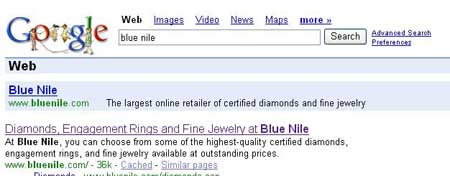Something that analytical folks talk a lot about is “the incremental”. In customer marketing, it’s not enough to get response, what we want to know is how much of the response was above and beyond what we could be expected had the test or promotion not been done. Typically incrementality is measured using control groups – people just like the people you are sending the campaign to who do not receive the campaign. Then you compare the profitability of the people who received the campaign versus the profitability of those who didn’t. The difference is the true, incremental profitability of the campaign.
Kevin over at the MineThatData blog relates that Blue Nile has decided to lower prices as opposed to chasing rising ad costs. I don’t know enough about their business model to really comment on that action, but I do know one thing – they (and many, many other companies) are wasting Pay-Per-Click spend on non-incremental clicks.
Check out this shot. Search for Blue Nile in Google, you get a Pay-Per-Click ad for Blue Nile, and Blue Nile has the fiirst natural listing:

Now someone, somewhere, back in the beginning of PPC probably had a conference speech that told everybody to buy the search for your company’s brand name, maybe for “branding” or “exposure” purposes. But almost every web site ranks first in the natural rankings for their own brand name. So I ask you, is there any incremental here? What are the chances, if the PPC ad was not there, that the visitor searching “Blue Nile” would not click on the first natural listing?
What do you suppose the volume of this search is, and how much money is being wasted by people clicking on the paid ad who would have clicked on the natural link anyway? I asked the same question back in 2003, and though the structure of the test wasn’t as pure as most hard core test & control folks would like to see, the results were so dramatic that you can’t really argue much with the methodology. A few percentage points here or there and you still get to the same place.
In this particular test, on a high volume PPC phrase for a site that also had a top 3 natural ranking, 77% of PPC sales were non-incremental – stolen from the natural side – and would have happened anyway without the PPC link.
I will be the first to say that results are going to vary a lot by the type of site, the phrase, the target audience, the search engine, and so on. But Golly Gee folks, has anybody else ever questioned the wisdom of “railroading” a top natural listing with a paid listing – and especially for your own brand name? I bet a lot of analytical folks have, they just couldn’t convince the marketing folks to test it. After all, addressing / fixing this by taking down the PPC ad means:
1. There will probably be a few lost sales, perhaps from people who for whatever reason, always click on paid ads (newbies?) However, profits will increase. Some folks will not believe in this idea, it’s that whole analytical culture problem. You have to trust the numbers, not fear them. Unless, of course, you have been specifically told to grow sales and not profits. Rare, but it does happen.
2. Then there is the whole “How could you not know this was a bad thing and continue doing it for so long?” problem. That’s more analytical culture stuff. Failure is a learning experience in the analytical culture, not a cause for whippings and firings and demotions. The question is not how much money was lost, the question is how much will be saved going forward. Right?
3. Potentially, some PPC budget will be reallocated to other, more profitable marketing activities. This could be a problem if there is “ego spend” involved in the management of PPC. I wouldn’t move the money out of PPC, I would just find better ways to use the existing budget. But the potential exists for losing it for a higher and better purpose that is proven out by the numbers. Just optimizing the system, no hard feelings, right?
PPC Marketers, if you’d like to free up budget for something else, ask your web analytics folks if they can track this test for you. Locate a high volume search phrase that you buy PPC for ads for where your web site naturally ranks as #1 or #2 for the same phrase. Try shutting the PPC for that phrase off. How much click volume do you lose versus the cost of the clicks when PPC is tuned on, and what does that translate into in terms of increased profit?
And I am really not picking on Blue Nile here – search any brand name, online or off. Go ahead. What do you see?
Would you fail to click on the organic link if the paid link was not there? Really? If you think you’d miss the organic link if the PPC link wasn’t there, send me a pic of the example.